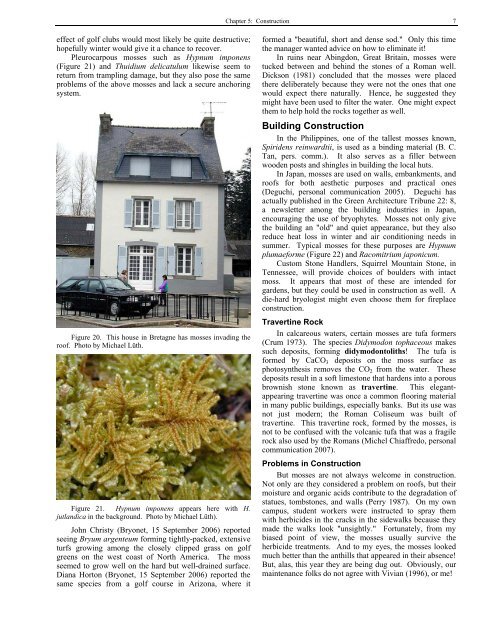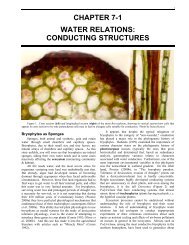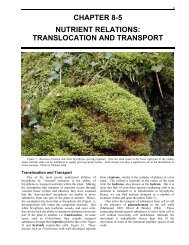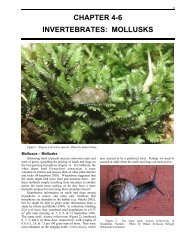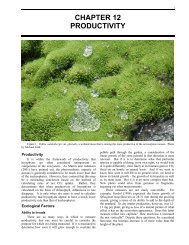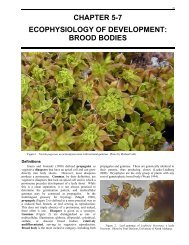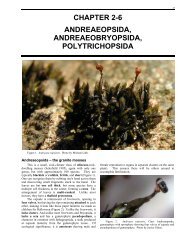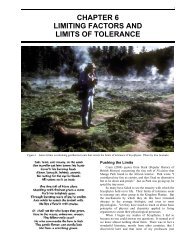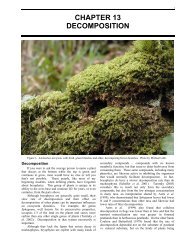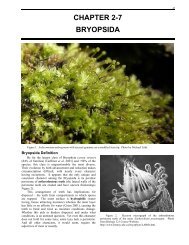Chapter 5: Construction - Bryophyte Ecology
Chapter 5: Construction - Bryophyte Ecology
Chapter 5: Construction - Bryophyte Ecology
Create successful ePaper yourself
Turn your PDF publications into a flip-book with our unique Google optimized e-Paper software.
effect of golf clubs would most likely be quite destructive;<br />
hopefully winter would give it a chance to recover.<br />
Pleurocarpous mosses such as Hypnum imponens<br />
(Figure 21) and Thuidium delicatulum likewise seem to<br />
return from trampling damage, but they also pose the same<br />
problems of the above mosses and lack a secure anchoring<br />
system.<br />
Figure 20. This house in Bretagne has mosses invading the<br />
roof. Photo by Michael Lüth.<br />
Figure 21. Hypnum imponens appears here with H.<br />
jutlandica in the background. Photo by Michael Lüth).<br />
John Christy (Bryonet, 15 September 2006) reported<br />
seeing Bryum argenteum forming tightly-packed, extensive<br />
turfs growing among the closely clipped grass on golf<br />
greens on the west coast of North America. The moss<br />
seemed to grow well on the hard but well-drained surface.<br />
Diana Horton (Bryonet, 15 September 2006) reported the<br />
same species from a golf course in Arizona, where it<br />
<strong>Chapter</strong> 5: <strong>Construction</strong><br />
formed a "beautiful, short and dense sod." Only this time<br />
the manager wanted advice on how to eliminate it!<br />
In ruins near Abingdon, Great Britain, mosses were<br />
tucked between and behind the stones of a Roman well.<br />
Dickson (1981) concluded that the mosses were placed<br />
there deliberately because they were not the ones that one<br />
would expect there naturally. Hence, he suggested they<br />
might have been used to filter the water. One might expect<br />
them to help hold the rocks together as well.<br />
Building <strong>Construction</strong><br />
In the Philippines, one of the tallest mosses known,<br />
Spiridens reinwardtii, is used as a binding material (B. C.<br />
Tan, pers. comm.). It also serves as a filler between<br />
wooden posts and shingles in building the local huts.<br />
In Japan, mosses are used on walls, embankments, and<br />
roofs for both aesthetic purposes and practical ones<br />
(Deguchi, personal communication 2005). Deguchi has<br />
actually published in the Green Architecture Tribune 22: 8,<br />
a newsletter among the building industries in Japan,<br />
encouraging the use of bryophytes. Mosses not only give<br />
the building an "old" and quiet appearance, but they also<br />
reduce heat loss in winter and air conditioning needs in<br />
summer. Typical mosses for these purposes are Hypnum<br />
plumaeforme (Figure 22) and Racomitrium japonicum.<br />
Custom Stone Handlers, Squirrel Mountain Stone, in<br />
Tennessee, will provide choices of boulders with intact<br />
moss. It appears that most of these are intended for<br />
gardens, but they could be used in construction as well. A<br />
die-hard bryologist might even choose them for fireplace<br />
construction.<br />
Travertine Rock<br />
In calcareous waters, certain mosses are tufa formers<br />
(Crum 1973). The species Didymodon tophaceous makes<br />
such deposits, forming didymodontoliths! The tufa is<br />
formed by CaCO3 deposits on the moss surface as<br />
photosynthesis removes the CO2 from the water. These<br />
deposits result in a soft limestone that hardens into a porous<br />
brownish stone known as travertine. This elegantappearing<br />
travertine was once a common flooring material<br />
in many public buildings, especially banks. But its use was<br />
not just modern; the Roman Coliseum was built of<br />
travertine. This travertine rock, formed by the mosses, is<br />
not to be confused with the volcanic tufa that was a fragile<br />
rock also used by the Romans (Michel Chiaffredo, personal<br />
communication 2007).<br />
Problems in <strong>Construction</strong><br />
But mosses are not always welcome in construction.<br />
Not only are they considered a problem on roofs, but their<br />
moisture and organic acids contribute to the degradation of<br />
statues, tombstones, and walls (Perry 1987). On my own<br />
campus, student workers were instructed to spray them<br />
with herbicides in the cracks in the sidewalks because they<br />
made the walks look "unsightly." Fortunately, from my<br />
biased point of view, the mosses usually survive the<br />
herbicide treatments. And to my eyes, the mosses looked<br />
much better than the anthills that appeared in their absence!<br />
But, alas, this year they are being dug out. Obviously, our<br />
maintenance folks do not agree with Vivian (1996), or me!<br />
7


